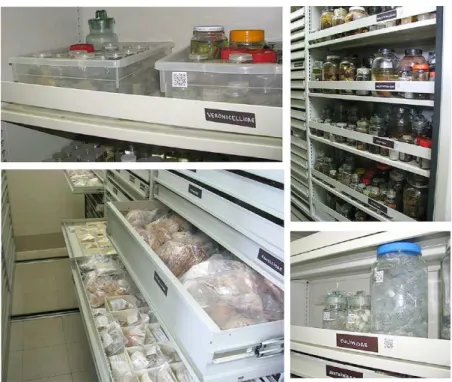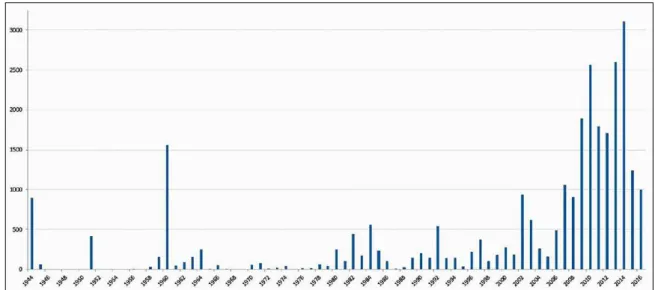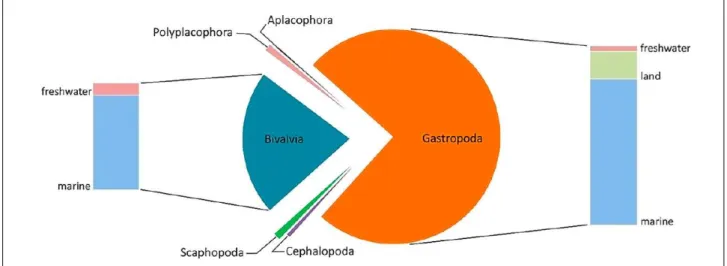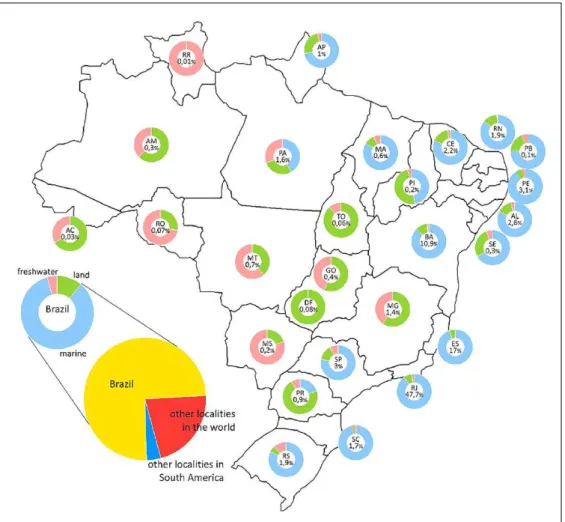Arquivos de Ciências do Mar
THE MOLLUSCA COLLECTION OF THE MUSEU NACIONAL
/ UFRJ – HISTORICAL SYNTHESIS
Coleção de Mollusca do Museu Nacional: Síntese Histórica
1 Associate Professor, Curator of the Mollusca Collection in Departamento de Invertebrados, Museu Nacional, UFRJ. Quinta da Boa Vista s/n, Rio de Janeiro, RJ, Brasil. CEP 20940-040. E-mail: alexpim@mn.ufrj.br
Alexandre Dias Pimenta1
ABSTRACT
The Mollusca Collection at the Museu Nacional/UFRJ is the oldest and one of the largests in Brazil. Currently, it includes 39,631 registered lots of all molluscan classes, except Monoplacophora. Most of the lots are from Brazilian localities, but specimens from foreign localities are also represented. Marine species are the most represented, but specimens from terrestrial and limnic species are also deposited as well as material from Sambaqui´s sites. The collection holds 671 type lots of 347 molluscan names, including 132 holotypes and a neotype. The collection beginning dates from the end of 19th century and grew at different rates along its history, as the result of intensive samplings along Brazil and also
donations of private collections.
Keywords: Scientiic Collection, biodiversity, molluscs.
RESUMO
A Coleção de Mollusca do Museu Nacional/UFRJ é a mais antiga e uma das maiores no Brasil. Atualmente, ela
inclui 39.631 lotes registrados de todas as classes do ilo, exceto Monoplacophora, além de muitos outros em processo de
tombamento. A maioria dos lotes provêm de localidades no Brasil, mas espécies de localidades no exterior também estão representadas. Espécies marinhas são as mais representativas, mas espécies de ambientes terrestre e límnico também estão depositadas, assim como material de sítios de Sambaqui. A coleção abriga 671 lotes de tipos, de 347 nomes, sendo 132
holótipos e um neótipo. A coleção teve seu início no inal do século XIX e cresceu em diferentes taxasao longo de sua
história, como resultado de coletas intensivas no Brasil, e também pela doação de coleções particulares.
INTRODUCTION
The Museu Nacional is the oldest Brazilian
scientiic institution and one of the most important natural history museums in Brazil. It was founded in 1818, by D. João of Portugal, after the institution of the “Reino Unido de Portugal, do Brasil e do Algarves”, in 1815, along with other important Governmental Institutions. Formerly named Museu Real, it was renamed Museu Nacional, after the Proclamation of the Republic in 1889, being transferred to its present location in Quinta da Boa Vista, in 1892. Since 1946, it is an institute of the Universidade Federal do Rio de Janeiro (UFRJ).
Since the beginning of its academic, scientiic and educational activities, the Museu Nacional incorporated important collections of natural history and anthropology. The Mollusca Collection stored in Museu Nacional is the oldest of its kind in Brazil.
HISTORICAL SYNTHESIS OF THE
MOLLUSCA COLLECTION IN
THE MUSEU NACIONAL
The early beginning of the Mollusca Collection of the Museu Nacional is somewhat dificult to establish, but published reports of malacological material housed in Museu Nacional date since the end of 19th century.
In the work “Investigações Historicas e Scientiicas sobre o Museu Imperial e Nacional do Rio de Janeiro”, Netto (1870: 304) mentioned that several molluscs were in exhibition in the irst building of Museu Nacional (by that time named Museu Real), in the currently Praça da República, downtown Rio de Janeiro. Lacerda (1905: 96), in “Fatos do Museu Nacional do Rio de Janeiro”, mentioned that the (probably) same
specimens were exhibited in the current building of Museu Nacional, in 1892, already in Quinta da Boa Vista. Although both authors did not mention the number of specimens, it is implicit that a formal zoological collection was already established.
In 1924, Alípio de Miranda Ribeiro, in “Noções Syntheticas de Zoologia Brasílica”, elaborated a list of
molluscs from Brazil, based on the malacological collection in Museu Nacional, which had been studied by E. von Martens, from Germany.
The irst record of an organized catalogue book dates from the irst years of the 1930s, elaborated by Paulo de Miranda Ribeiro, representing the old numbering of the collection of the Divisão de Zoologia (from 30,001 to 36,302). In 1942, Emmanoel de
Azevedo Martins, naturalist of the “Divisão de Geologia”, became responsible for the Mollusca Collection and started a new catalogue numbering, which is continued in the present. From 1950, the eminent naturalist specialized in vertebrate paleon tology, Fausto Luiz de Souza Cunha, was responsible for the collection, and indicated the young enthusiast of molluscs, Arnaldo Coelho, who in 1956, became formally responsible for the collection.
The collection inally had a specialist in malacology, who contributed to the physical reformulation of the collection that started growing and diversifying. Professor Arnaldo Coelho develo ped his studies with the important supervision of Dr. Hugo de Souza Lopes, a dipterologist from Instituto Oswaldo Cruz in Rio de Janeiro (IOC), but also interested in malacology. Dr. Hugo de Souza Lopes owned a large private molluscan collection, stored in IOC, which was donated to Museu Nacional in 1970, being incorporated to the Mollusca Collec tion. Professor Arnaldo Coelho retired in 1996, but kept working in the following years, while Dra. Norma Salgado was the formal responsible for the collection, until her retirement in 2008.
PHYSICAL STRUCTURE AND
INFORMATIZATION OF RECORDS
The Mollusca collection is housed in the main building of Museu Nacional, in about 30 m2 (Figures 12). The Physical structure of the collection was revitalized in 2005, with the acquisition of 42 sliding cabinets and an ethanol reservoir for large cephalopods, as result of a cooperation between Museu Nacional and Fundação Vitae; in 2008, with the inancial support of CENPESPetrobras, the collection room was climatized and in 2014, the computing equipment used for cataloging the collection was modernized with inancial assistance of FAPERJ (Fundação Carlos Chagas Filho de Am paro à Pesquisa do Estado do Rio de Janeiro).
The data about the material stored in the collection is computerized using the software Harpia, developed by NCE/UFRJ in the decade of 1980. Around 91.5% of the lots are computerized, with the expectancy of being full by the middle of 2017. It is also planned to migrate the database to the software Specify, along with the remaining zoological collections of the Museu Nacional.
includes 12,750 records of the Mollusca collection and can be used for queries (http://gbif.sibbr.gov.br/ explorador/pt/recurso/169).
SIZE AND GROWTH OF
THE COLLECTION
By July 2016, the collection housed a total of 39,631 registered lots, including about 235,000 specimens, being around 20% of the lots preserved in ethanol while 80% consists of dry shells. There are yet, a large amount of material waiting to be catalogued, that will result in additional 10,000 lots, according to our estimates.
Along the years, important ield expeditions contributed to the growth of the collection. Among them, some historical ones, as “Comissão Rondon”, in
Mato Grosso, in 19071915; and the pioneers “Expedição Bruno Lobo”, in 1916 and “Expedição João Alberto”, in
1905, both to Trindade Island.
Also relevant were the “Recenseamento Faunístico do Distrito Federal (Rio de Janeiro)”, in the 1950s;
“Comissão Oceanográica Norte Nordeste”, in the 1960s;
among others. More recently, important surveys in marine environments yielded material to the collection, mainly: Marion-Dufresne cruise 55, in 1987, mainly in
VitóriaTrindade seamounts, off southeast Brazil;
“Programa REVIZEE” (mainly score Central), of the
Figure 1. General view of the room of the Mollusca Collection at the Musem Nacional and Prof. Arnaldo Coelho working in the old room of the collection (ca. 1960).
“Ministério do Meio Ambiente” (between 1996 and 2001); “Caracterização Ambiental de Águas Profundas da Bacia de Campos”, promoted by CENPESPetrobras,
between 2001 and 2006; Projects Habitats (20082009) and Ambes (20102013), respec tively, in the Campos and Espírito Santo Basins, southeast Brazil.
Donations and exchange of material were also common practices, especially in the middle of the 20th century, when cooperation with eminent malaco
logists in Brazil was conducted by Professsor Arnaldo Coelho, including, among others: Professor Eliezer C. Rios (MORG), Professor Henry R. Matthews (LABOMAR/UFC and UFERSA); as well as foreigner Museums, as Museo Argentino de Ciencias Naturales, Museo Nacional de Historia Natural y Antropologia, among others.
The annual growth rate of the collection, since the record of the irst lot of the current numbering system, in 1944, is presented in Figure 3. The moments of intensive growth can be traced according to some facts, such as: the beginning of the activities by Dr. Arnaldo Coelho, in the beginning of decade of 1960; the end of the 1970’s and along the 1980’s and 1990’s, when the irst students formed by the “Programa de PósGraduação em Ciências Biológicas (Zoologia) of UFRJ”, created in 1974, were actively working; and from 2006 onwards, when the Mollusca Collection received the material of several projects, specially from Campos Basin, in eastern Brazil, as well as a new generation of students actively working on their own graduate projects, mainly in the taxonomic revision of families of marine microgastropods.
Some moments of great growth are due to the donation of entire private collections. The most important is the collection of Dr. Hugo de Souza Lopes, in 1970 (8,062 lots). Recently, another im portant donation was of the private collection of Dr. Luiz Roberto Tostes (2,407 lots). Also the malaco logical parcel of the zoological collection from Instituto Oswaldo Cruz was incorporated to the Mollusca Collection.
Taxonomic, temporal and geographic coverage
The taxonomic coverage of the collection includes the six out of the seven molluscan classes, only Monoplacophora is not represented. The remaining classes are represented according to Figure 4. Currently, 6,231 molluscan species are catalogued in the collection, but several lots determined as ‘sp.’ or ‘spp.’ are included, representing, in many cases, potential material for taxonomic studies.
Marine species lots are the most re presentative (~ 82.9%), but material from terrestrial (~ 12,3%), and limnic (~4.8%) environ ments are also deposited (Figure 4). Some lots of material from Sambaqui deposits are also present, but in a small scale, while no fossil material is stored, since Museu Nacional includes important collections speciically for archaeological material and inver tebrate paleontology.
Considering the lots from marine environ ments, about 85% are from littoral or continental shelf localities, while 15% are from deep sea (below depth of 200 m).
The oldest material was collected in the decade of 1870, including several lots from the United States incorporated to Museu Nacional by the cooperation with C. F. Hartt and O. A. Derby, during the
“Comissão Geológica do Império”, from 1875 to 1878.
Figure 4. Representability of the Mollusca Collection at the Museu Nacional by class and environment.
Figure 5 Most representative families in the Mollusca Collection at the Museu Nacional.
TYPE MATERIAL
Currently (July, 2016), there are 671 type lots for 347 names, including 132 holotypes and one neotype. A revision of the type material of species described until 2013 was published by Pimenta et al. (2014).
Ackowledgements: The author would like to
acknowledge Dr. Cristina Rocha Barreira and Dr. Helena MatthewsCascon, for the invitation to take part in this volume. The Mollusca Collection/UFRJ received the following inancial support in the last years: FAPERJ (Fundação Carlos Chagas Filho de Amparo à Pesquisa do Estado do Rio de Janeiro) through project E–26/110.325/2014 and “As Coleções Biológicas de Invertebrados e Vertebrados do Museu Nacional/MNRJ digitalização, informatização e
Figure 6 Geographic representability of the Mollusca Collection at the Museu Nacional. Small circles in the Brazilian map, indicate the percentage of lots by state, the color sectors indicate the environment: blue = marine; green = land; magenta = freshwater.
dis poni bilização dos dados no Sistema de Informação sobre a Biodiversidade Brasileira/SiBBr”, Processo CNPQ no. 401887/20146.
BIBLIOGRAPHIC REFERENCES
Lacerda, J.B. Fastos do Museu Nacional do Rio de Janeiro.
Imprensa Nacional, iv + 188 pp. Rio de Janeiro, 1905. Netto, L. Investigações Historicas e Scientiicas sobre o Museu Imperial e Nacional do Rio de Janeiro. Instituto Philomatico, iv + 310 + x pp., Rio de Janeiro, 1870. Pimenta, A. D.; Monteiro, J. C.; Barbosa, A. F.; Salgado, N. C. & Coelho, A. C. S. Catalogue of the type specimens deposited in the Mollusca Collection of the Museu Nacional / UFRJ, Rio de Janeiro, Brazil.



